Renewables Rescue Stability as the Grid Loses Spin
Across the world, renewable power is displacing traditional generation, but can renewables also replace the critical stability functions that go with it? NREL studies are confirming in the field and on live power systems that solar, wind, and hybrid power plants can provide their own source of grid stability—potentially unlike anything currently on the grid.
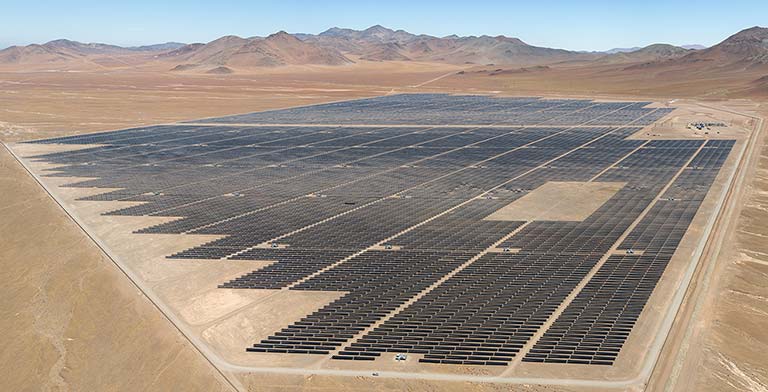
The Luz del Norte plant in the remote Atacama desert of Chile—among the driest, most irradiated locations on the planet. Photo courtesy of First Solar
Sept. 15, 2020 | By Connor O'Neil | Contact media relations
The high-altitude Atacama Desert of northern Chile is a surprising location for scientific insights: Its dry and dusty likeness to Mars makes it ideal for interplanetary testing, and distant worlds are particularly visible to telescopes through the altiplano’s clear night skies. But it is the area's record amount of solar radiation that enabled the National Renewable Energy Laboratory's (NREL's) own breakthrough in the Atacama: a proof that bulk renewable resources can stabilize the power grid.
A Power Systems Discovery in the Desert
"There is a myth that says renewable energy produces instability on electrical grids and that we need conventional generation to compensate it," said Gabriel Ortiz Mercado, an asset manager at First Solar, which developed and operates a 141-MW, thin-film photovoltaic (PV) solar power plant in the Atacama named Luz del Norte.
"On the contrary, our PV plant Luz del Norte is now demonstrating with NREL algorithms that renewables can contribute to maintaining the stability of the electrical grid and facilitate the incorporation of more renewables."
Ortiz Mercado leads the management of Luz del Norte, which came online in 2016, the same year that NREL Chief Engineer Vahan Gevorgian collaborated with First Solar and the California Independent System Operator (CAISO) to demonstrate advanced reliability services by solar power plants. Ortiz Mercado was a hemisphere away watching that study happen, imagining something similar with the new plant in Chile.
"We wanted to keep the First Solar-NREL project alive in Chile," said Ortiz Mercado. "So, we decided to go one step further and use the innovative controls on the Chilean power system."
The California study was a technical demonstration that solar power plants could participate in ancillary service markets; First Solar wanted to demonstrate a plant that truly was participating in the market, and Luz del Norte was in the right place to make it happen. Few power systems outside of Chile allow solar to fully participate in ancillary service markets, a result of the perception that renewables are uncertain. And to be fair, the team struggled for over a year with configuring, tuning, and accurately predicting the facility's power output—a basic requirement for market participation.
With such high uncertainty in the plant's available power, the grid operator was unable to rely on Luz del Norte for energy reserves. Throughout the first year of effort, Luz del Norte was not allowed to participate in the ancillary services market, and the first true application of the California study was appearing out of reach.
"Then I remembered another paper from Vahan," said Ortiz Mercado, describing a method created by Gevorgian for estimating power accurately and in real time. "We put in that formula and it worked perfect right away."
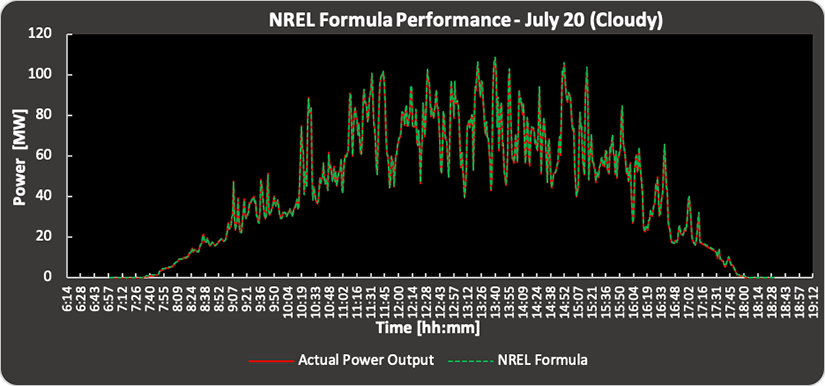
The true power output from Luz del Norte compared with the estimated power output using NREL's method. Image courtesy of First Solar
"What Vahan solved in a simple way is very complicated. You have so many variables for estimating power—temperature, forecasts, cloud cover, efficiencies, losses, available equipment, sensors, and degradation," Ortiz Mercado said. "Vahan showed that a more accurate approach is to instead use some of the plant inverters for reference."
With that change to estimating power, Luz del Norte was admitted into Chile's ancillary services market in June 2020, making it the first known utility-scale solar power plant to participate in the full range of fast-response grid reliability services.
"A PV plant is a data-to-electron process," said Ortiz Mercado. "The fact that utility-scale PV plants are totally electric, static, and digital, without mechanical or thermodynamic parameters like speed, pressure, inertia, or chemical composition of fluids, makes PV plants more reliable, accurate, and faster than conventional technologies for the provision of ancillary services that maintain grid stability and reliability."
Past the Stigma of Unstable Power
Luz del Norte helped solar energy earn its stripes in the capacity market alongside other generation technologies. But projecting out to a future with even more renewables, can solar and wind become the power system's main source of stability?
"It is a complex question, touching on both economic and technical issues," Gevorgian said. "Originally, markets would provide the maximum amount of clean energy, but now that so many traditional power plants are being retired, we need someone to provide the other services that are being lost. We need market mechanisms that incentivize renewable power plants to curtail energy and use it for reserves."
Technically, the question hinges on a large distinction between variable renewable energy and traditional generation: Varaible renewables are not equipped with the large spinning masses (generators and turbines) found in traditional power plants (with wind as a semi-exception). The inertia of those rotating masses is an anchor of stability for the grid, maintaining a steady 60 or 50 Hz of electrical supply. By comparison, variable renewables that are inverter-based resources (IBRs) can be programmed to provide synthetic inertia—a digital substitute for mechanical inertia that can be produced using controls.
Mechanical inertia has historically been so fundamental to grid stability to be practically taken for granted. But with the introduction of IBRs, essential grid reliability services have come to every grid operator's attention, with the result that grid services from IBRs are now in need of both technical validation and market compensation. Such stability services are procured from power generators at various timescales—the complete state of affairs in grid services is clarified in this NREL report.
Gevorgian and other researchers at NREL are showing that absent mechanical inertia,IBRs are still capable of supporting the grid alongside traditional resources. Beyond the example of solar and Luz del Norte, Gevorgian, in collaboration with CAISO, Avangrid, and GE, recently helped demonstrate wind-farm-specific grid support from Avangrid's 131.1-MW Tule Wind Farm near San Diego. Tule was programmed with a GE controller to respond to grid-stabilizing requests from CAISO every 4 seconds—the report is a wind-power analogue to Gevorgian's solar power report that first mobilized Ortiz Mercado in 2016. And in a report related to energy storage, an NREL team reviewed example use cases of battery storage systems providing grid stability in U.S. and China power systems.
Hybrid Hopes
Capping off with a highlight of systems where variable renewable energy has provided grid-friendly support, NREL studies have shown that variable power is not necessarily leading to an unstable power system. In fact, NREL is finding that the right mix of renewables and controls creates a new, uniquely capable type of power plant.
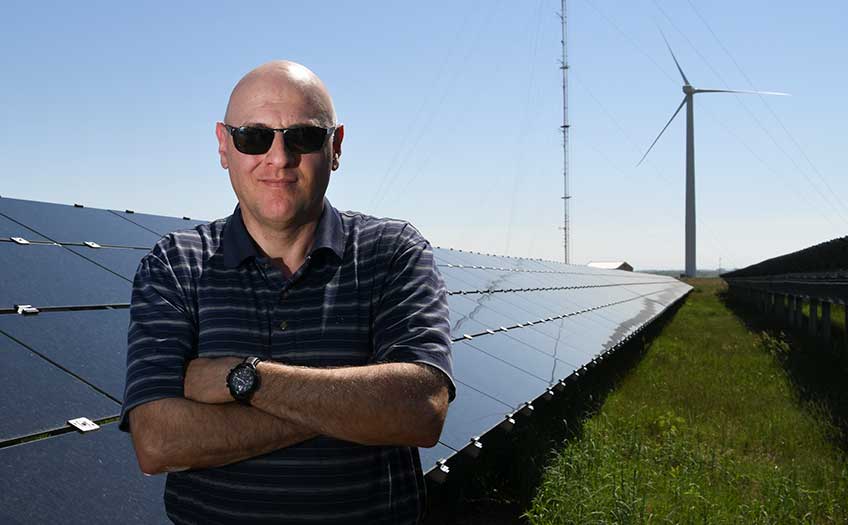
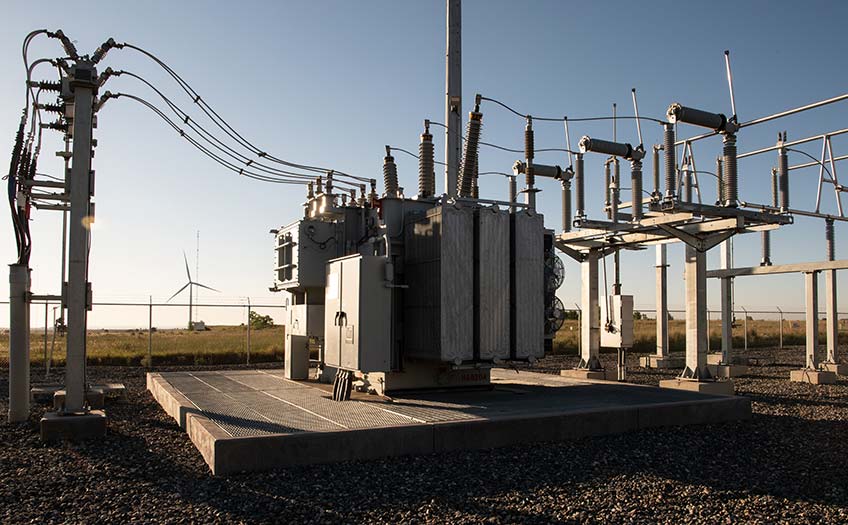
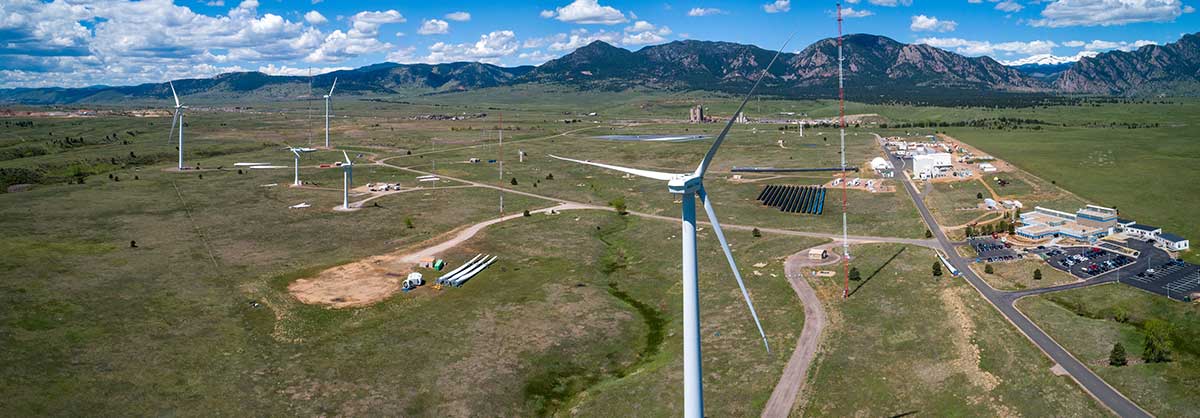
NREL Chief Engineer Vahan Gevorgian works within a hybrid power plant at NREL’s Flatirons Campus, where grid-scale utility assets and numerous renewable energy and storage technologies come together for integrated energy systems research. Photos by Dennis Schroeder and Josh Bauer
"Our next step is to explore hybrid, with various renewables working side by side," Gevorgian said. "By co-locating wind and solar with batteries, we can achieve highly dispatchable and flexible generation with provision of many types of grid services at the plant level."
The hybrid hope is that by combining wind and solar generation with energy storage, or even in combination with hydro power storage in some cases, renewable energy systems can more closely mirror the behavior of conventional power plants.
At NREL's Flatirons Campus, Gevorgian and a team of researchers effectively manage NREL's own hybrid power plant. The campus contains multiple megawatts of wind turbines, solar photovoltaic arrays, and battery storage systems, as well as other generation technologies connected to 2.5-MW and 5-MW dynamometers, all of which operate behind a controllable grid interface that researchers use to simulate normal and extreme conditions that can be present on the larger grid.
Within that sandbox of bulk energy assets, Gevorgian and the team are free to explore the limits of large-scale IBR integration: How can hybrid plants be controlled for most efficient use of their individual components and with maximum benefits to the grid? Can hybrid plants safely recover from disturbances? How can they enhance grid stability at different time scales? And ultimately, what is their role in an evolving power grid with increasing IBRs and a decreasing share of mechanical inertia?
Gevorgian leads several DOE-sponsored projects that investigate those topics. Among them, the Grid Modernization Laboratory Consortium's FlexPower project sees an opportunity for hybrid renewable plants to have a more active role in reliability, perhaps beyond what conventional plants can provide.
"We expect to develop controls that will convert the role of renewables from bulk variable energy providers into a technology that is dispatchable, flexible, and involved in real-time services to the grid," Gevorgian said.
The FlexPower project will result in a controller that optimizes and coordinates the output from mixed renewable assets. The controller will receive market signals and forecasts, and it will direct the response from the hybridized assets. Meanwhile, the grid interface allows Gevorgian to explore disruption scenarios that a live power plant could encounter.
In that environment, which will soon incorporate an even greater mix of research assets like hydrogen electrolyzers and electric vehicle charging stations, NREL can validate stability controls under the most severe events facing IBR-dominant systems.
Such studies have begun to flip the paradigm for critical grid operations: When a traditional grid blackstarts following a power outage, it is repowered top-down, reaching distribution systems last. When IBR-dominant systems recover from blackstart, the grid can repower from the bottom up with synchronized distributed resources.
NREL results indicate that these systems are functional substitutes for conventional power plants as grids trend toward low inertia. But what about no inertia?
New Ideas for a No-Spin Grid
There are more than a few islands, microgrids, communities, cities, states, and countries that have declared initiatives to reach 100% renewable-based generation. Technically, in many cases that also means 100% IBR and 100% non-mechanical inertia. At NREL, that has raised a question: Do we need inertia at all?
"As we go higher and higher in our share of renewables, maybe the mentality will switch from trying to accommodate mixed generation systems, to building around inverter-based resources," said NREL Manager of Integrated Devices and Systems Barry Mather.
To date, IBRs have been mostly defined by grid-following behavior on power systems. Inverters are programmed to follow and respond to the frequency from spinning generators, which have universally occupied a larger share of generation. Mather is leading an NREL-directed research project into grid-forming inverters, named infinite inertia inverters (I3)—a project that anticipates a possible flip to majority (or entirely) IBR systems.
"I3 is somewhat futuristic, but it is one more technology to help tackle the issues of very high IBR generation," Mather said. "The idea of I3 is to come up with a new way to operate assets in synchrony—to maintain synchrony during disturbances or when a new load comes online, without depending on the synchrony of spinning generators."
I3 takes inverter-based systems a step further, totally untethering inverter frequencies from other resources. With I3, 60 Hz is not derived from spinning generators, or from advanced software—it actually comes from space.
Grid-forming inverters are not new to NREL—I3's forerunner, virtual oscillator controls, have helped stabilize certain power systems transitioning to low inertia. But even those controls are in part dependent on spinning generators: The inverter frequencies rely on the rest of the grid to derive their 60 Hz clocks. I3 takes IBR systems a step further, totally untethering inverter frequencies from other resources. With I3, 60 Hz is not derived from spinning generators, or from advanced software—it actually comes from space.
"I3 leverages incredibly high-accuracy clock signals from GPS," Mather said. "The useful aspect of I3 is that the grid is always on 60 Hz—it is not dependent on an imbalance of load. If our systems are transitioning to purely IBRs, then grid frequency doesn't have to change."
Mather explained, "Currently, if you have a fault and voltage goes down, a bunch of inverters will trip off. The way our system is today, the inverters will wait some time—maybe five minutes—to come back online, as other generation comes online first and establishes the system frequency. With I3, the fault is cleared by relay equipment, and inverter-based generators can turn back online in a split second."
In this way, I3 functionally supports the distant objective of autonomous energy systems—it can facilitate easy islanding, reconnection, and microgrid-like operation without fear of frequency-related destabilization. Though distant, I3 represents one more set of tools to safely integrate ever greater shares of renewables.
A Stable Future from Renewables
The decrease in spin on the power grid has put the spotlight on stability. As renewables ramp up across the world, NREL has worked to recreate the subtle and extensive grid services inherent in synchronized rotations. Each solution bridges renewables a bit further toward full integration on the energy system.
"At NREL, we are trying to tackle the issues of high renewable integration at all different time scales," Mather said. "We are building technological bridges. I3 is one technology, but there are many more."
The time scales of grid stability exist in the day-ahead down to seconds—as in the majority of Gevorgian's work—and in the sub-second range, as in I3. The services also span function, simultaneously focusing on the ability to recover from a system outage, the ability to reserve power for surplus demand, and the ability to maintain stable frequency or voltage. NREL is intent on covering this spread of topics with an equal spread of technological solutions.
While widespread high-IBR systems are still years out, and although there are further opportunities for research and development related to hybrid power plants, the methods being validated at NREL are showing real-system importance. In the near term, systems like Luz del Norte are leading industry at the frontiers of renewable operations—and now, with an expansion of research capabilities, NREL's stability studies will reach future systems that continue the transition to a reliable and renewable power grid.
Share
Last Updated May 1, 2025





